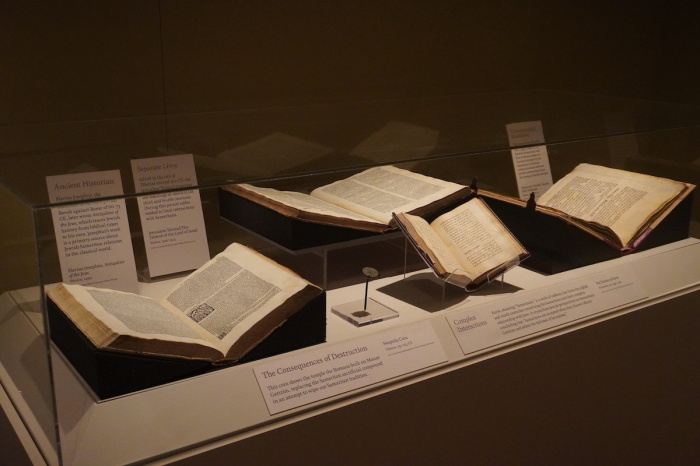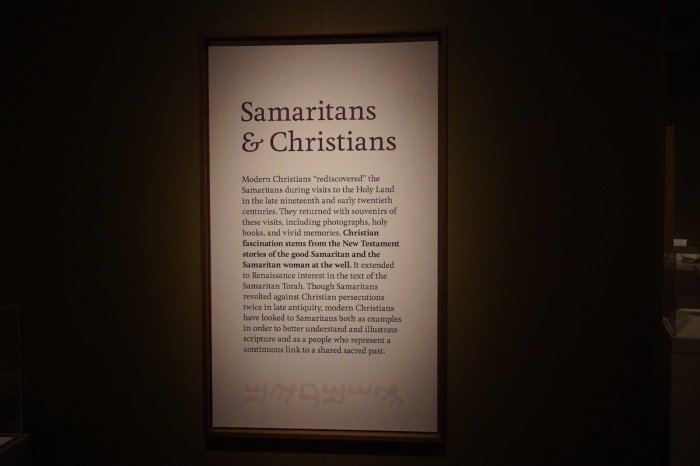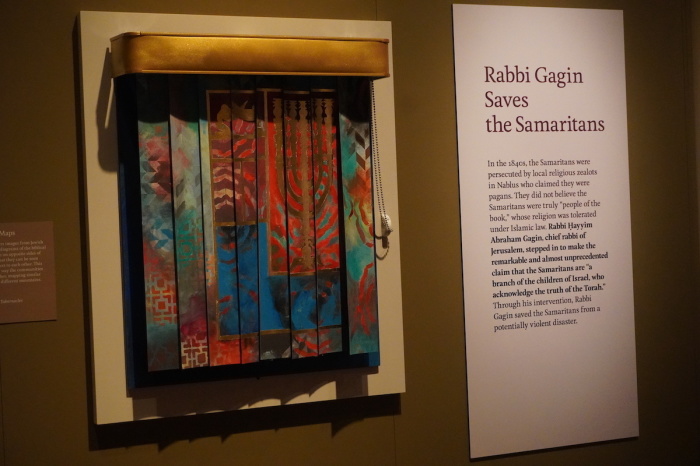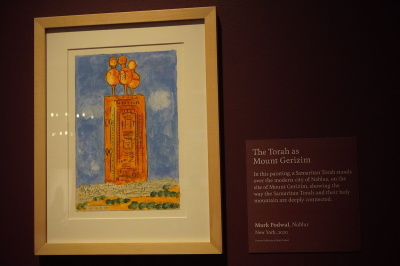Bible museum opens unprecedented Samaritans exhibit with ancient inscription loaned by Israeli president

WASHINGTON — The Museum of the Bible has opened what curators say is one of the first exhibits to its scale illuminating the history of the Samaritan people group, which features an ancient stone inscription loaned by Israel President Isaac Herzog.
The new exhibition, "The Samaritans: A Biblical People," opened Thursday in partnership with the Yeshiva University Center For Israel Studies under the direction of Steven Fine, the Dean Pinkhos Churgin Chair in Jewish History. The exhibition will run through Jan. 1, 2023.
The museum highlights how the Samaritans are not just a people group mentioned in biblical and rabbinic texts but still exist as a micro community numbering roughly 850 people in the modern world.
"The exhibition is an exploration of a centuries-old community that dates right from the Bible and explores biblical people the Samaritans, understanding their culture, their traditions, and different encounters between different religious groups," said Christy Wallover, the developer who worked with the curators, designers and others to make the exhibit possible.
A large stone inscription originally from the medieval Samaritan synagogue in Kefar Kalil was loaned for the exhibition by the Israeli presidential residence and the Israel Antiquities Authority. According to the museum, the Samaritan Hebrew inscription was published by Itzhak Ben-Zvi, a scholar of Samaritan history and the second president of Israel.
"This is a story that reflects the many voices that make up our social tapestry and the many textured layers of history that contribute to our collective human story here in the Holy Land," Herzog said of the exhibition. "I'm grateful to the Museum of the Bible, to Yeshiva University Center for Israel Studies, and to the many able minds and hands that have come together to bring this exhibition to life and the story of this special community, the Samaritan community, to a broad public."
The inscription is among six objects on loan from Israel.

According to the museum texts, the Samaritans as a people group once comprised 1 million members who endured great persecution.
Wallover told The Christian Post that the museum hopes to give visitors an understanding of the traditions still remaining among the Samaritans today.
"I think the new exhibition will really help our audience understand the Samaritans as not only people that show up in the Bible, in the New Testament, but as people within their own culture, within their own history and really grounded in the context of how this ancient community is also a modern contemporary community that thrives today," Wallover said.
David Selis, the assistant curator from Yeshiva University Center For Israel Studies, worked alongside Fine and Jesse Abelman, curator of Hebraica and Judaica at the Museum of the Bible.
"For me, the most exciting part about the museum opening was all the stories that nobody really knew about that we basically dug up," Selis said. "The purpose of this exhibit is, firstly, no one's ever done this. There have been very few Samaritan exhibits. No one's done something on this scale."
"We get to now tell this complex story of the Samaritans in this scale of complexity and to tell how they were perceived and how they interacted with Muslims, Jews and Christians," he continued. "So, a big part of this is just telling a story that's never been told in this way before."
Wallover believes visitors will walk away with a better understanding of history surrounding the Biblical depiction of the Samaritans.

Wallover helped with the interpretive design, organizing of the themes, writing and editing of the texts seen throughout the exhibition. She also helped create the different pathways through the exhibit.
The exhibition is set up as an "open concept," allowing people to choose their own paths as they explore the different sections comprised of differing narratives that all pass through the same people and places, according to Selis. He said the exhibition gives patrons "a full picture of the rich history of Samaritans who were presented as a partly-Jewish group in biblical texts."
"I think this museum will challenge the way people view Samaritans. I think for Jews especially, we read about Samaritans as 'those annoying people who mess with our calendar in the rabbinic texts' and as those people who 'don't believe what we do and they're wrong.' And hearing them go, 'You people, you've got the wrong mountain.' And let's make it worse, 'the wrong Torah and the wrong priest.' These are things Jews are used to," Selis said.
"We read our texts, and our sectarians don't talk back to us. So having the people that we read about as the second temple sectarians suddenly being a group that I can go visit in Tel Aviv completely changes them from being these 'bad people' to people who are alive today and part of Israeli society. And it makes them much more complicated and much more interesting, I think, from the Jewish perspective for Christians and for Muslims."
Wallover said she is excited for visitors to come across the massive mosaic in the middle of the floor and the immersive sukkah, a temporary structure typically used during the week-long Jewish festival of Sukkot.

"I'm also excited for people to see interesting objects which take Samaritan Hebrew and translate it into Jewish Hebrew. It's one of a kind. It's unique. … I'm really excited for people to viscerally take in all these things and pieces of content and really learn about the history of the Samaritans."
The exhibition is accessible not only to the general public but also to those with disabilities.
"Not only did we want to make sure that there were big enough font sizes and that wheelchairs can get through, but we also wanted to make sure that the text is understandable and that people can get these concepts that are sometimes very complex and complicated," she said. "We really worked hard to make the exhibit accessible for all people."
Abelman told CP that while "the Samaritan story is such a complex and unknown story by much of the world," "everyone is connected to them through the Bible and through their lives across the centuries and millennia."
"Christians, Jews and everybody has been in touch with them in different ways and at different times," Abelman said.
"One thing we have talked about in the context of this exhibit is Samaritans can sometimes function as a mirror for us. Jews in an obvious way as a sort of Israelites who have a very different way of practicing and understanding the Torah and all of those things. But also Christians in the way that they're trying to hold onto the connection to the Bible and to the world in the face of modernity, which can sometimes be a struggle."

Abelman hopes visitors will see the depiction of Samaritans and their struggles and triumphs and be able to see their own struggles and triumphs. He also hopes it will spark "intriguing dialogue that will shape generations for years to come."
"I look forward to people seeing the exhibit and talking about it. I can talk about all the pieces forever: a stone with the Ten Commandments from an ancient synagogue on the one hand, and on the other hand, you have announcements from the contemporary Samaritan synagogue," Abelman described.

"And so, you can see both the antiquity, the ancient heritage and elements from the Bible and also the ongoing life that they continue to live. I'm excited for people to see things like this and learn about these people and begin to have conversations with each other."
Moses Alafi, a Jerusalem-based documentary film creator, created all the documentary film clips shown on screens throughout the exhibit.
Alafi said the clips demonstrate that "the Samaritan people are truly a living legacy."
"The Samaritan people are real, living and breathing people today. The exhibition, the books, and the films all bring the entire story of the Samaritans to life. Behind the scenes, it's not just to tell a historical story. It's not just to promote the Samaritans," Alafi said.
"When I am doing a documentary film, it's for us. It's for the people who watch it, to see, to learn and to ask ourselves questions as Jewish, as Christian, as people who share the same five books and to think what we can learn from them."
The entire feature film titled "The Samaritans: A Biblical People" will be shown during a screening on Friday.

Alafi said his goal was to show the "community's struggle and to share how to deliver their traditions to the next generation."
"As an Orthodox religious Jew, I think that any religious community all over the world, ... we are struggling with how to deliver our traditions because we have to fight with the internet and with social media. And in this society, we cannot ignore that," Alafi stated.
"As a father and grandfather, I want my children and grandchildren to follow my faith. So when we watch the story about the Samaritan community, we are trying to find different ways to overcome struggle and to win in the struggle, and we can then learn about ourselves in the process."



























